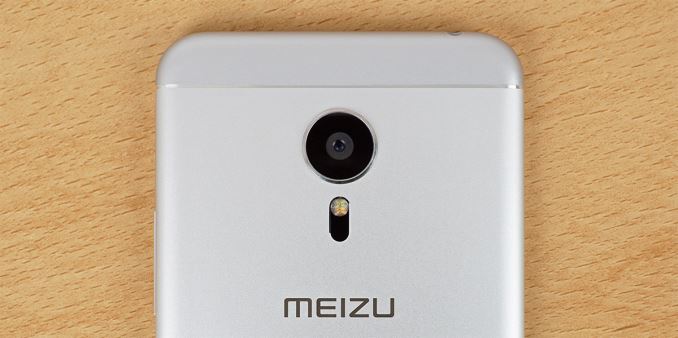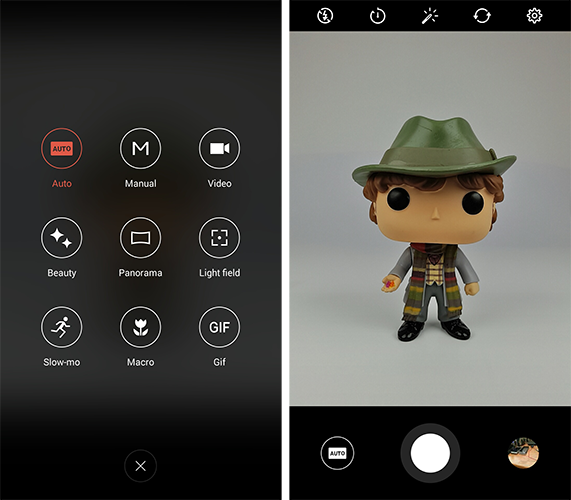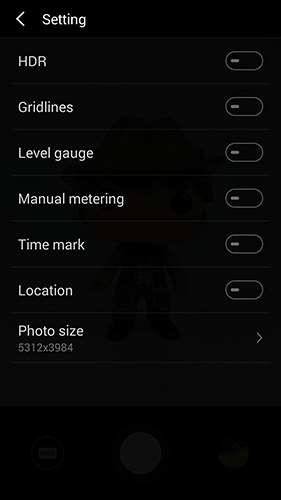The Meizu PRO 5 Review
by Matt Humrick on June 24, 2016 8:00 AM EST- Posted in
- Smartphones
- Exynos
- Mobile
- Meizu
- Exynos 7420
Camera Hardware
The PRO 5’s rear camera uses a Sony IMX230 Exmor RS sensor that captures up to 21MP images with a 4:3 aspect ratio. This is the same sensor used in Motorola’s Moto X Pure Edition, which takes nice pictures in good lighting but struggles a bit in lower-light scenes—partly because of software processing and partly from a lack of optical image stabilization (OIS). The PRO 5 also lacks OIS. We’ll see how this impacts its low-light performance in the next section.
The rear camera’s strength is its hybrid autofocus system that combines phase detect autofocus (PDAF)—using up to 192 AF points on the Sony sensor—laser autofocus, and traditional contrast-based AF as a fallback to provide fast, reliable focusing under a range of lighting conditions. This is still a rare feature; most phones, even the most expensive flagships from Apple and Samsung, only combine two AF methods, either PDAF/contrast or laser/contrast. But combining PDAF and laser makes sense: PDAF works well at longer distances and in good lighting, while laser works well at short distances and in poor lighting.
| Camera Architecture | |
| Meizu PRO 5 | |
| Front Camera: Resolution | 5MP |
| Front Camera: Sensor | OmniVision OV5670 (1.12µm, 1/5") |
| Front Camera: Focal Length | 2.64mm (27mm equivalent) |
| Front Camera: Aperture | f/2.0 |
| Rear Camera: Resolution | 21.16MP |
| Rear Camera: Sensor | Sony IMX230 Exmor RS (1.12µm, 1/2.4") |
| Rear Camera: Focal Length | 4.73mm (27mm equivalent) |
| Rear Camera: Aperture | f/2.2 |
Positioned in front of the rear camera sensor is a 6-element LARGAN lens system that helps improve sharpness near the edges of the image, according to Meizu. The 27mm focal length (35mm equivalent) is fairly typical for smartphone cameras today. Shorter focal lengths increase field of view at the expense of magnification (objects in the image will be comparatively smaller than what is seen by the naked eye for focal lengths less than about 50mm). Because most smartphone cameras lack optical zoom lenses, there’s no way to compensate for the this effect without either compromising image quality by using digital zoom or physically getting closer to the subject. This is why I personally do not like the current trend towards shorter focal lengths.
The lens’ aperture is important, because it determines how much light reaches the sensor. The PRO 5’s f/2.2 lens gives it an aperture area 10% larger than the Huawei P9 and 30% larger than the iPhone 6s Plus; however, its aperture area is 15% smaller than the Nexus 6P and Moto X Pure Edition and 26% smaller than the Galaxy S7, which currently has the largest aperture area of any smartphone. The lack of OIS and an aperture area that’s merely average could hold back the PRO 5’s low-light performance.
The 5MP front-facing camera uses an OmniVision OV5670 sensor, which we’ve also seen in the Asus ZenFone 2. This choice is a little disappointing, because of its small format; smaller sensors capture less light. Many competing phones use 5MP cameras with a 1/4" format and larger 1.4µm pixels.
Camera UX
Meizu’s camera app has a very basic user interface in the default Auto mode. Located along one edge are controls for the flash and timer, along with a toggle to apply various image filters. The HDR control is in the settings menu, which is accessed by tapping the gear icon. With Meizu’s camera app, HDR is either on or off—there’s no automatic HDR mode—so not having an HDR toggle in the main UI is inconvenient.
Tapping the button to the left of the shutter button opens the camera mode selection menu, shown on the left in the screenshot above. Most of the modes are self explanatory. The “Gif” mode, for example, records a six-second video and turns it into a 320x320 animated gif. The “Light field” mode’s label is a bit misleading. It’s actually a selective focus mode that rapidly takes between five to ten pictures at different focal distances. This allows you to change the object in focus later in post-processing. The feature works as intended, but image size is restricted to only 5MP, which significantly degrades quality. It’s also worth noting that the Panorama, Light field, Macro, and Slow-mo modes are not available when using the front-facing camera.
The settings menu is pretty simple, providing control over a few additional features as well as photo and video resolution. There’s an optional level gauge feature that turns the shutter button into a pseudo-bubble-level; however, the level is laggy and inaccurate, making it far less useful than just lining up your shot by using the grid lines. It’s nice to see an option for manual metering, though, which allows you to set focus and exposure points independently.
Meizu’s camera app also provides a manual mode, although it’s not on par with LG’s or Samsung’s. The first issue is that the UI is fixed to portrait mode and does not rotate into landscape mode. This also affects the settings and camera modes menus, which are also portrait only. Another issue, primarily affecting the saturation, contrast, and white balance controls, is that the adjustment slider only offers a few preset values rather than a continuous range of adjustment. This oversight makes these controls next to useless. Finally, there’s no live preview of changes to shutter speed and ISO, which turns image exposure into a guessing game. Because of these flaws, it’s best to just leave the PRO 5 in auto mode and ignore Meizu’s manual mode, correcting any subsequent shortcomings in software later.
No camera app would be complete without beauty and panorama modes. The beauty mode has controls to make your eyes larger, chin slimmer, and skin smooth and pale, but stops short of making you look like a space alien.















80 Comments
View All Comments
Impulses - Friday, June 24, 2016 - link
Yup, personally I don't care much for these reviews (unless the devices are more readily available in the USA) but I don't mind them either (the audio part here was very interesting!) AND I DO remember reading requests for Meizu/Xiaomi/etc reviews for a long long time in the comments section of older reviews... I've no doubt Andrei is right as far as the existing demand for this content.jimbo2779 - Friday, June 24, 2016 - link
I think it's great to see brands that are not just us centric.aryonoco - Friday, June 24, 2016 - link
Thanks Andrei.I have no problems with phones targeting different markets being reviewed. In fact as someone from Australia, I like that AT seems to be less NA focused recently.
Can I just ask that reviews list the LTE bands supported clearly in the spec table? It really is as important as storage or camera spec, at least. I know which bands my carrier uses, so if the LTE bands are listed, I'd know if the phone is useful for me or not. Sometimes finding exactly the LTE bands that some of these Chinese phones support is not at all east.
asfletch - Monday, June 27, 2016 - link
At least most Chinese phones support band 3, which is common to all the major carriers here in Australia. Makes them much more attractive for us than for US buyers. Many also support Band 40, which is used by Optus. Support for Bands 5 and 28 is rare though, so we tend not to get the fastest available service on Chinese handsets.LiverpoolFC5903 - Tuesday, July 5, 2016 - link
Thank you!The likes of Meizu, Xiaomi,Oppo, Vivo, Huawei, ZTE, One plus and others have a lot of good stuff to offer and at mostly great prices.
Keep doing what you are doing, love the content on here.
andychow - Sunday, June 26, 2016 - link
I agree with you %100. Anandtech doesn't review %20 of available phones, why would they review phones incompatible with North American LTE? Cover us first, then cover the in-compatible phones with a big warning. America comes first. That's the truth.more-or-less - Friday, June 24, 2016 - link
BTW to all AT editors, can you include comments using Facebook/Twitter/Google/Disqus etc., I have been reading for years, yet never wanted to create a seperate account for commenting.Impulses - Friday, June 24, 2016 - link
Disqus is annoying AF... IMO Only good part about it are email notifications, but it loads slow and doesn't look that great.Eden-K121D - Friday, June 24, 2016 - link
AnandTech is too goddamn lazy and lethargic to bring the S7 review part 2 or HTC 10 review or GTX 1080/70 reviwGeranium - Friday, June 24, 2016 - link
@AnandTech,Why you guys are putting Android benchmark and iOS benchmark in same chart? Aren't those different platform?